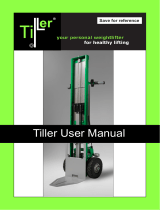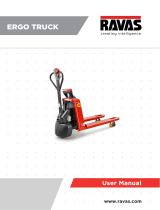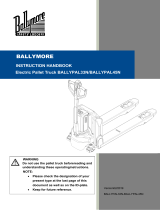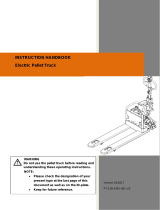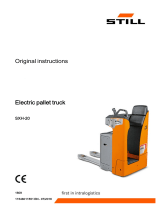Page is loading ...

Operating Instructions
51016305
EJE 230 G
G
08.99 -
04.05

0108.GB
Foreword
The present ORIGINAL OPERATING INSTRUCTIONS are designed to provide
sufficient instruction for the safe operation of the industrial truck. The information is
provided clearly and concisely. The chapters are arranged by letter. Each chapter
starts with page 1. The page identification consists of a chapter letter and a page
number.
For example: Page B 2 is the second page in chapter B.
The operating instructions detail different truck models. When operating and servicing
the truck, make sure that the instructions apply to your truck model.
Safety instructions and important explanations are indicated by the following
graphics:
FUsed before safety instructions which must be observed to avoid danger to
personnel.
MUsed before notices which must be observed to avoid material damage.
ZUsed before notices and explanations.
tUsed to indicate standard equipment.
oUsed to indicate optional equipment.
Our trucks are subject to ongoing development. Jungheinrich reserves the right to
alter the design, equipment and technical features of the truck. No guarantee of
particular features of the truck should therefore be inferred from the present operating
instructions.
Copyright
Copyright of these operating instructions remains with JUNGHEINRICH AG.
Jungheinrich Aktiengesellschaft
Am Stadtrand 35
22047 Hamburg - GERMANY
Telephone: +49 (0) 40/6948-0
www.jungheinrich.com
0108.GB
Foreword
The present ORIGINAL OPERATING INSTRUCTIONS are designed to provide
sufficient instruction for the safe operation of the industrial truck. The information is
provided clearly and concisely. The chapters are arranged by letter. Each chapter
starts with page 1. The page identification consists of a chapter letter and a page
number.
For example: Page B 2 is the second page in chapter B.
The operating instructions detail different truck models. When operating and servicing
the truck, make sure that the instructions apply to your truck model.
Safety instructions and important explanations are indicated by the following
graphics:
FUsed before safety instructions which must be observed to avoid danger to
personnel.
MUsed before notices which must be observed to avoid material damage.
ZUsed before notices and explanations.
tUsed to indicate standard equipment.
oUsed to indicate optional equipment.
Our trucks are subject to ongoing development. Jungheinrich reserves the right to
alter the design, equipment and technical features of the truck. No guarantee of
particular features of the truck should therefore be inferred from the present operating
instructions.
Copyright
Copyright of these operating instructions remains with JUNGHEINRICH AG.
Jungheinrich Aktiengesellschaft
Am Stadtrand 35
22047 Hamburg - GERMANY
Telephone: +49 (0) 40/6948-0
www.jungheinrich.com

0108.GB
0108.GB

I 1
0405.GB
Index
A Correct use and application
B Truck Description
1 Application ........................................................................................... B 1
2 Assemblies .......................................................................................... B 2
3 Standard Version Specifications ......................................................... B 3
3.1 Performance data for standard trucks ................................................. B 3
3.2 Dimensions ......................................................................................... B 3
3.3 EN norms ............................................................................................ B 5
3.4 Conditions of use ................................................................................ B 5
4 Identification points and data plates .................................................... B 6
4.1 Truck data plate .................................................................................. B 7
4.2 Capacity plate, Order, Inventory and Service Nos. ........................... B 7
C Transport and Commissioning
1 Lifting by crane .................................................................................... C 1
2 Securing the truck during transport ..................................................... C 1
3 Using the truck for the first time .......................................................... C 2
4 Operating the truck without its own drive system (emergency
operation) ............................................................................................ C 3
D Battery Maintenance, Charging & Replacement
1 Safety regulations for handling acid batteries ..................................... D 1
2 Battery types ....................................................................................... D 2
3 Exposing the battery ........................................................................... D 2
4 Charging the battery ............................................................................ D 3
5 Battery removal and installation .......................................................... D 4
6 Combination instrument (o) ................................................................ D 5
I 1
0405.GB
Index
A Correct use and application
B Truck Description
1 Application ........................................................................................... B 1
2 Assemblies .......................................................................................... B 2
3 Standard Version Specifications ......................................................... B 3
3.1 Performance data for standard trucks ................................................. B 3
3.2 Dimensions ......................................................................................... B 3
3.3 EN norms ............................................................................................ B 5
3.4 Conditions of use ................................................................................ B 5
4 Identification points and data plates .................................................... B 6
4.1 Truck data plate .................................................................................. B 7
4.2 Capacity plate, Order, Inventory and Service Nos. ........................... B 7
C Transport and Commissioning
1 Lifting by crane .................................................................................... C 1
2 Securing the truck during transport ..................................................... C 1
3 Using the truck for the first time .......................................................... C 2
4 Operating the truck without its own drive system (emergency
operation) ............................................................................................ C 3
D Battery Maintenance, Charging & Replacement
1 Safety regulations for handling acid batteries ..................................... D 1
2 Battery types ....................................................................................... D 2
3 Exposing the battery ........................................................................... D 2
4 Charging the battery ............................................................................ D 3
5 Battery removal and installation .......................................................... D 4
6 Combination instrument (o) ................................................................ D 5

0405.GB
I 2
E Operation
1 Safety Regulations for the Operation of Forklift Trucks ...................... E 1
2 Controls and Displays ......................................................................... E 2
2.1 Truck with standard tiller ..................................................................... E 2
3 Starting up the truck ............................................................................ E 4
4 Industrial truck operation ..................................................................... E 5
4.1 Safety regulations for truck operation ................................................. E 5
4.2 Travel, Steering, Braking ..................................................................... E 6
4.3 Collecting and depositing loads .......................................................... E 9
4.4 Parking the truck securely ................................................................... E 9
4.5 Troubleshooting .................................................................................. E 10
F Forklift Truck Maintenance
1 Operational safety and environmental protection ................................ F 1
2 Maintenance Safety Regulations ........................................................ F 1
3 Servicing and inspection ..................................................................... F 3
4 Maintenance Checklist ....................................................................... F 4
5 Lubrication Schedule ........................................................................... F 6
5.1 Consumables ...................................................................................... F 7
6 Maintenance Instructions .................................................................... F 8
6.1 Preparing the truck for maintenance and repairs ................................ F 8
6.2 Opening the battery panel. .................................................................. F 8
6.3 Open the front panel ........................................................................... F 8
6.4 Checking electrical fuses .................................................................... F 9
6.5 Recommissioning ................................................................................ F 10
7 Decommissioning the forklift truck ...................................................... F 10
7.1 Prior to decommissioning: ................................................................... F 10
7.2 During decommissioning: .................................................................... F 10
7.3 Recommissioning ................................................................................ F 11
8 Safety tests to be performed at intervals and after unusual events
(D: Accident prevention check according to BGV D27 .................... F 11
9 Final de-commissioning, disposal ....................................................... F 11
0405.GB
I 2
E Operation
1 Safety Regulations for the Operation of Forklift Trucks ...................... E 1
2 Controls and Displays ......................................................................... E 2
2.1 Truck with standard tiller ..................................................................... E 2
3 Starting up the truck ............................................................................ E 4
4 Industrial truck operation ..................................................................... E 5
4.1 Safety regulations for truck operation ................................................. E 5
4.2 Travel, Steering, Braking ..................................................................... E 6
4.3 Collecting and depositing loads .......................................................... E 9
4.4 Parking the truck securely ................................................................... E 9
4.5 Troubleshooting .................................................................................. E 10
F Forklift Truck Maintenance
1 Operational safety and environmental protection ................................ F 1
2 Maintenance Safety Regulations ........................................................ F 1
3 Servicing and inspection ..................................................................... F 3
4 Maintenance Checklist ....................................................................... F 4
5 Lubrication Schedule ........................................................................... F 6
5.1 Consumables ...................................................................................... F 7
6 Maintenance Instructions .................................................................... F 8
6.1 Preparing the truck for maintenance and repairs ................................ F 8
6.2 Opening the battery panel. .................................................................. F 8
6.3 Open the front panel ........................................................................... F 8
6.4 Checking electrical fuses .................................................................... F 9
6.5 Recommissioning ................................................................................ F 10
7 Decommissioning the forklift truck ...................................................... F 10
7.1 Prior to decommissioning: ................................................................... F 10
7.2 During decommissioning: .................................................................... F 10
7.3 Recommissioning ................................................................................ F 11
8 Safety tests to be performed at intervals and after unusual events
(D: Accident prevention check according to BGV D27 .................... F 11
9 Final de-commissioning, disposal ....................................................... F 11

1
0506.GB
Appendix
JH Traction Battery Operating Instructions
ZThese operating instructions apply only to Jungheinrich battery models. If using
another brand, refer to the manufacturer's operating instructions.
1
0506.GB
Appendix
JH Traction Battery Operating Instructions
ZThese operating instructions apply only to Jungheinrich battery models. If using
another brand, refer to the manufacturer's operating instructions.

0506.GB
2
0506.GB
2

A 1
0600.GB
A Correct use and application
ZThe “Guidelines for the Correct Use and Application of Industrial Trucks” (VDMA) are
supplied with the truck. The guidelines form part of these operating instructions and
must be observed. National regulations apply in full.
The truck described in the present operator manual is an industrial truck designed for
lifting and transporting load units.
It must be used, operated and serviced in accordance with the present instructions.
Any other type of use is beyond the scope of application and can result in damage to
personnel, the truck or property. In particular, avoid overloading the truck with loads
which are too heavy or placed on one side. The data plate attached to the truck or the
load diagram are binding for the maximum load capacity. The industrial truck must
not be used in fire or explosion endangered areas, or areas threatened by corrosion
or excessive dust.
Proprietor responsibilities: For the purposes of the present operator manual the
“proprietor” is defined as any natural or legal person who either uses the industrial
truck himself, or on whose behalf it is used. In special cases (e.g. leasing or renting)
the proprietor is considered the person who, in accordance with existing contractual
agreements between the owner and user of the industrial truck, is charged with
operational duties.
The proprietor must ensure that the truck is only used for the purpose it is designed
for and that all dangers to life and limb of the user and third parties are avoided.
Furthermore, accident prevention regulations, safety regulations and operating,
servicing and repair guidelines must be followed. The proprietor must ensure that all
truck users have read and understood this operator manual.
MFailure to comply with the operator manual shall invalidate the warranty. The same
applies if improper work is carried out on the truck by the customer or third parties
without the permission of the manufacturer’s customer service department.
Attaching accessories: The mounting or installation of additional equipment which
affects or supplements the performance of the industrial truck requires the written
permission of the manufacturer. In some cases, local authority approval shall be
required.
Approval of the local authorities however does not constitute the manufacturer’s
approval.
A 1
0600.GB
A Correct use and application
ZThe “Guidelines for the Correct Use and Application of Industrial Trucks” (VDMA) are
supplied with the truck. The guidelines form part of these operating instructions and
must be observed. National regulations apply in full.
The truck described in the present operator manual is an industrial truck designed for
lifting and transporting load units.
It must be used, operated and serviced in accordance with the present instructions.
Any other type of use is beyond the scope of application and can result in damage to
personnel, the truck or property. In particular, avoid overloading the truck with loads
which are too heavy or placed on one side. The data plate attached to the truck or the
load diagram are binding for the maximum load capacity. The industrial truck must
not be used in fire or explosion endangered areas, or areas threatened by corrosion
or excessive dust.
Proprietor responsibilities: For the purposes of the present operator manual the
“proprietor” is defined as any natural or legal person who either uses the industrial
truck himself, or on whose behalf it is used. In special cases (e.g. leasing or renting)
the proprietor is considered the person who, in accordance with existing contractual
agreements between the owner and user of the industrial truck, is charged with
operational duties.
The proprietor must ensure that the truck is only used for the purpose it is designed
for and that all dangers to life and limb of the user and third parties are avoided.
Furthermore, accident prevention regulations, safety regulations and operating,
servicing and repair guidelines must be followed. The proprietor must ensure that all
truck users have read and understood this operator manual.
MFailure to comply with the operator manual shall invalidate the warranty. The same
applies if improper work is carried out on the truck by the customer or third parties
without the permission of the manufacturer’s customer service department.
Attaching accessories: The mounting or installation of additional equipment which
affects or supplements the performance of the industrial truck requires the written
permission of the manufacturer. In some cases, local authority approval shall be
required.
Approval of the local authorities however does not constitute the manufacturer’s
approval.

0600.GB
A 2
0600.GB
A 2

B 1
0405.GB
B Truck Description
1 Application
The EJE series comprises three-wheel trucks with a steered drive wheel and two
sprung, cushioned and pivoting caster wheels contained within the geometry of the
truck.
The EJE is designed to transport goods on level surfaces. The truck can lift open
bottom or diagonal board pallets as well as roll cages beyond the load wheel area.
The capacity of the truck is shown on the data plate or the data capacity plate Qmax.
The truck is custom-made with a doubling of the load forks for a minimum load entry
height of 110mm.
Truck types, capacity and motor output:
Type Capacity Motor output
EJE 230 3,000 kg 1.5 kW
B 1
0405.GB
B Truck Description
1 Application
The EJE series comprises three-wheel trucks with a steered drive wheel and two
sprung, cushioned and pivoting caster wheels contained within the geometry of the
truck.
The EJE is designed to transport goods on level surfaces. The truck can lift open
bottom or diagonal board pallets as well as roll cages beyond the load wheel area.
The capacity of the truck is shown on the data plate or the data capacity plate Qmax.
The truck is custom-made with a doubling of the load forks for a minimum load entry
height of 110mm.
Truck types, capacity and motor output:
Type Capacity Motor output
EJE 230 3,000 kg 1.5 kW

0405.GB
B 2
2 Assemblies
Item EJE 230 Description
1tKey switch
2oCombination instrument (battery discharge
monitor and hourmete)
3tMain switch / isolator (emergency disconnect)
4tTiller and grip
5tSafety button
6tController
7tBattery panel
8tLoad forks
9tFront panel
10 tCaster wheel
11 tDrive wheel
12 tCrawl button
1
2
3
4
5
7
9
1110 10
8
12
6
0405.GB
B 2
2 Assemblies
Item EJE 230 Description
1tKey switch
2oCombination instrument (battery discharge
monitor and hourmete)
3tMain switch / isolator (emergency disconnect)
4tTiller and grip
5tSafety button
6tController
7tBattery panel
8tLoad forks
9tFront panel
10 tCaster wheel
11 tDrive wheel
12 tCrawl button
1
2
3
4
5
7
9
1110 10
8
12
6

B 3
0405.GB
3 Standard Version Specifications
ZTechnical data specified in accordance with VDI 2198.
Technical modifications and additions reserved.
3.1 Performance data for standard trucks
*) For longer fork lengths the load centre of gravity is in the centre of the forks
3.2 Dimensions
*) Load section raised - 75 mm
**) Ast diagonal as per VDI +196 mm
Ast for shunting - 230 mm
***) Other fork lengths available for special truck designs.
Description EJE 230
Q Capacity 3000 kg
C Load centre distance for standard fork length
*)
600 mm
Travel speed with rated load / w.o. load 5.0 / 6.0 km/h
Lift speed (lift) with rated load / w.o. load 4.3 / 6.7 cm/s
Max. gradeability (5 min rating)
with / without load
8 / 20 %
Description EJE 230
h2Lift 125 mm
h13 Load fork lowered 90 mm
y Wheelbase *)
Load section lowered
1670 mm
L Truck length (= L2 + l) 1990 mm
L2Headlength 840 mm
l Fork length 1150*** mm
B Truck width 790 mm
Wa Turning radius *)1830 mm
Ast Working aisle width **)
800 x 1200 longit.
2250 mm
B 3
0405.GB
3 Standard Version Specifications
ZTechnical data specified in accordance with VDI 2198.
Technical modifications and additions reserved.
3.1 Performance data for standard trucks
*) For longer fork lengths the load centre of gravity is in the centre of the forks
3.2 Dimensions
*) Load section raised - 75 mm
**) Ast diagonal as per VDI +196 mm
Ast for shunting - 230 mm
***) Other fork lengths available for special truck designs.
Description EJE 230
Q Capacity 3000 kg
C Load centre distance for standard fork length
*)
600 mm
Travel speed with rated load / w.o. load 5.0 / 6.0 km/h
Lift speed (lift) with rated load / w.o. load 4.3 / 6.7 cm/s
Max. gradeability (5 min rating)
with / without load
8 / 20 %
Description EJE 230
h2Lift 125 mm
h13 Load fork lowered 90 mm
y Wheelbase *)
Load section lowered
1670 mm
L Truck length (= L2 + l) 1990 mm
L2Headlength 840 mm
l Fork length 1150*** mm
B Truck width 790 mm
Wa Turning radius *)1830 mm
Ast Working aisle width **)
800 x 1200 longit.
2250 mm

0405.GB
B 4
h13 h2
B
Ast
850
y
L2
L
1305
C
Q
0405.GB
B 4
h13 h2
B
Ast
850
y
L2
L
1305
C
Q

B 5
0405.GB
3.3 EN norms
Noise emission: 64 dB(A)
in accordance with EN 12053 as harmonised with ISO
4871.
ZThe noise emission level is calculated in accordance with standard procedures and
takes into account the noise level when travelling, lifting and when idle. The noise
level is measured at the driver’s ear.
Vibration: 0.77 m/s2
In accordance with EN 13059.
ZThe vibration acceleration acting on the body in the operating position is, in
accordance with standard procedures, the linearly integrated, weighted acceleration
in the vertical direction. It is calculated when travelling over bumps at constant speed.
Electromagnetic compatibility (EMC)
The manufacturer confirms that equipment complies with
tolerance levels for electromagnetic emissions and
resistance as well as static electricity discharge testing in
accordance with EN 12895 including the normative
procedures contained therein.
ZNo changes to electric or electronic components or their arrangement may be made
without the written agreement of the manufacturer.
3.4 Conditions of use
Ambient temperature
- operating at 5 °C to 40 °C
ZSpecial equipment and authorisation is required if the truck is to operate constantly
below 5 °C or in a cold store or in extreme temperatures or conditions of fluctuating
air humidity.
B 5
0405.GB
3.3 EN norms
Noise emission: 64 dB(A)
in accordance with EN 12053 as harmonised with ISO
4871.
ZThe noise emission level is calculated in accordance with standard procedures and
takes into account the noise level when travelling, lifting and when idle. The noise
level is measured at the driver’s ear.
Vibration: 0.77 m/s2
In accordance with EN 13059.
ZThe vibration acceleration acting on the body in the operating position is, in
accordance with standard procedures, the linearly integrated, weighted acceleration
in the vertical direction. It is calculated when travelling over bumps at constant speed.
Electromagnetic compatibility (EMC)
The manufacturer confirms that equipment complies with
tolerance levels for electromagnetic emissions and
resistance as well as static electricity discharge testing in
accordance with EN 12895 including the normative
procedures contained therein.
ZNo changes to electric or electronic components or their arrangement may be made
without the written agreement of the manufacturer.
3.4 Conditions of use
Ambient temperature
- operating at 5 °C to 40 °C
ZSpecial equipment and authorisation is required if the truck is to operate constantly
below 5 °C or in a cold store or in extreme temperatures or conditions of fluctuating
air humidity.

0405.GB
B 6
4 Identification points and data plates
Item Description
13 "No passengers” warning
14 Capacity Qmax
15 Truck data plate
16 Plate, order, inventory and service nos.
17 Strap point for crane lifting
18 “Caution: Low voltage electronics”
19 UVV test label
14
15
16
17
Qmax
3000
kg
mV
1,5 V
18
19
1
2
1
1
1
0
9
8
7
6
5
4
3
2
1
1996
Ihr Kundendienst-Partner
13
0405.GB
B 6
4 Identification points and data plates
Item Description
13 "No passengers” warning
14 Capacity Qmax
15 Truck data plate
16 Plate, order, inventory and service nos.
17 Strap point for crane lifting
18 “Caution: Low voltage electronics”
19 UVV test label
14
15
16
17
Qmax
3000
kg
mV
1,5 V
18
19
1
2
1
1
1
0
9
8
7
6
5
4
3
2
1
1996
Ihr Kundendienst-Partner
13

B 7
0405.GB
4.1 Truck data plate
ZFor queries regarding the truck or ordering spare parts always quote the truck serial
number (21).
4.2 Capacity plate, Order, Inventory and Service Nos.
The capacity plate with the full service number is only issued when a service
agreement has been reached.
Item Description Item Description
20 Type 26 Manufacturer
21 Serial no. 27 Min./max. battery weight (kg)
22 Rated capacity (kg) 28 Output (kW)
23 Battery voltage V 29 Load centre of gravity (mm)
24 Net weight w.o. battery (kg) 30 Year of manufacture
25 Manufacturer’s logo 31 Option
Item Description
32 Order no.
33 Inventory no.
34 Full service no.
26
25
2724
2823
2922
3021
3120
32
33
34
B 7
0405.GB
4.1 Truck data plate
ZFor queries regarding the truck or ordering spare parts always quote the truck serial
number (21).
4.2 Capacity plate, Order, Inventory and Service Nos.
The capacity plate with the full service number is only issued when a service
agreement has been reached.
Item Description Item Description
20 Type 26 Manufacturer
21 Serial no. 27 Min./max. battery weight (kg)
22 Rated capacity (kg) 28 Output (kW)
23 Battery voltage V 29 Load centre of gravity (mm)
24 Net weight w.o. battery (kg) 30 Year of manufacture
25 Manufacturer’s logo 31 Option
Item Description
32 Order no.
33 Inventory no.
34 Full service no.
26
25
2724
2823
2922
3021
3120
32
33
34

0405.GB
B 8
0405.GB
B 8

C 1
0405.GB
C Transport and Commissioning
1 Lifting by crane
MOnly use lifting gear with sufficient capacity (for transport weight see truck data plate).
ZThe strap points (1) on the chassis and the load fork are for loading the truck with
crane lifting gear.
– Park the truck securely
(see Chapter E).
– Secure the lifting slings to
the attachment points (1).
MAttach the crane slings to the
strap points so that the truck
cannot slip, if necessary pull
them through the openings.
Lifting slings should be faste-
ned to the harness in such a
way that they do not come into
contact with any parts of the
truck when it is being raised.
2 Securing the truck during transport
The truck must be securely fastened when transported on a lorry or a trailer. The lorry
/ trailer must have fastening rings.
To fasten the truck pull the tensioning belt (3) over the truck (1) and attach it to the
fastening rings.
Tighten the tensioning belt
with the tensioner (4).
Loading must be carried out
by specially trained staff in
accordance with recommen-
dations contained in Guide-
lines VDI 2700 and VDI 2703.
In each individual case the
correct measurements must
be made and appropriate
safety measures applied.
3
1
4
C 1
0405.GB
C Transport and Commissioning
1 Lifting by crane
MOnly use lifting gear with sufficient capacity (for transport weight see truck data plate).
ZThe strap points (1) on the chassis and the load fork are for loading the truck with
crane lifting gear.
– Park the truck securely
(see Chapter E).
– Secure the lifting slings to
the attachment points (1).
MAttach the crane slings to the
strap points so that the truck
cannot slip, if necessary pull
them through the openings.
Lifting slings should be faste-
ned to the harness in such a
way that they do not come into
contact with any parts of the
truck when it is being raised.
2 Securing the truck during transport
The truck must be securely fastened when transported on a lorry or a trailer. The lorry
/ trailer must have fastening rings.
To fasten the truck pull the tensioning belt (3) over the truck (1) and attach it to the
fastening rings.
Tighten the tensioning belt
with the tensioner (4).
Loading must be carried out
by specially trained staff in
accordance with recommen-
dations contained in Guide-
lines VDI 2700 and VDI 2703.
In each individual case the
correct measurements must
be made and appropriate
safety measures applied.
3
1
4

0405.GB
C 2
3 Using the truck for the first time
MOnly operate the truck with battery current. Rectified AC current will damage the
electronic components. The battery leads (tow cable) must be less than 6m long.
To prepare the truck after delivery or after transport, proceed as follows:
– Check the truck for completeness and satisfactory condition of the equipment.
– Install battery (where required). Do not damage battery cable.
– Charge the battery (see Chapter D).
– If necessary, adjust the combination instrument to match the battery type (see
Chapter D).
– Commission the truck in accordance with instructions (see Chapter E).
ZWhen the truck is parked, the surface of the tyres will flatten. The flattening will
disappear after a short period of operation.
0405.GB
C 2
3 Using the truck for the first time
MOnly operate the truck with battery current. Rectified AC current will damage the
electronic components. The battery leads (tow cable) must be less than 6m long.
To prepare the truck after delivery or after transport, proceed as follows:
– Check the truck for completeness and satisfactory condition of the equipment.
– Install battery (where required). Do not damage battery cable.
– Charge the battery (see Chapter D).
– If necessary, adjust the combination instrument to match the battery type (see
Chapter D).
– Commission the truck in accordance with instructions (see Chapter E).
ZWhen the truck is parked, the surface of the tyres will flatten. The flattening will
disappear after a short period of operation.

C 3
0405.GB
4 Operating the truck without its own drive system (emergency operation)
To operate the truck in emergency conditions, the electromagnetically applied brake
must be released.
– Open and remove the front cover (2) (refer to chapter F).
– Turn the screws (3) anti-clockwise as far as the stop.
The truck can now be moved.
MWhen you park the truck, the screws (3) must be turned back clockwise as far as the
stop to restore full braking capability.
3
2
C 3
0405.GB
4 Operating the truck without its own drive system (emergency operation)
To operate the truck in emergency conditions, the electromagnetically applied brake
must be released.
– Open and remove the front cover (2) (refer to chapter F).
– Turn the screws (3) anti-clockwise as far as the stop.
The truck can now be moved.
MWhen you park the truck, the screws (3) must be turned back clockwise as far as the
stop to restore full braking capability.
3
2
/
